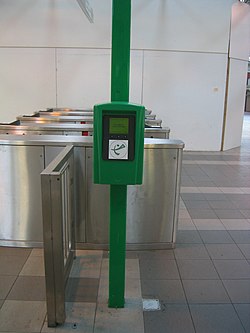| Location | Western Australia |
|---|---|
| Launched | 2007 |
| Manager | Public Transport Authority |
| Currency | AUD (A$256 maximum load) |
| Credit expiry | Never |
| Auto recharge | Autoload |
| Validity | |
| Retailed |
|
| Website | www |
This section needs to be updated. The reason given is: SmartRider Upgrade Project has been announced with testing expected to commence late 2023.(January 2024) |
SmartRider is the contactless electronic ticketing system of the Public Transport Authority of Western Australia. The system uses RFID smartcard technology to process public transport fares across public bus, train, and ferry services. [1]
Contents
- History
- Payment types
- SmartRider
- Contactless payments
- Fares
- Operation
- Passenger usage
- Technical detail
- Infrastructure
- SmartRider Hub
- Electronic transfer
- Onboard
- Retail
- Station design
- Reception
- Criticism
- Security
- Privacy
- Design
- Cost
- See also
- References
- External links
The system is widely used across the Transperth public transport network in metropolitan Perth, as well as regional town bus services in TransAlbany, TransBunbury, TransBusselton, TransEsperance, TransGeraldton, TransHedland, TransGoldfields, TransKarratha, and TransCarnarvon in Western Australian regional centres. [2] [3] SmartRider is not used for ticketing on Transwa train and coach services but can be recognized as proof of entitlement to concession fares, including for coach travel on South West Coach Lines. [2] [4]
The SmartRider is a credit card-sized physical smartcard incorporating a microchip and internal aerial, allowing the smartcard to communicate with processors located at Transperth railway stations, on Transperth ferries, and on Transperth and regional town bus services. The microchip enables value to be loaded onto the card, as well as allowing the journey details to be recorded and the appropriate fare deducted from the stored value on the card.
The SmartRider system is designed so that passengers can "tag on" and "tag off" any services whenever they travel through the public transport network. As of 2020–21, 78.9% of all fare-paying boardings were made using a SmartRider.







